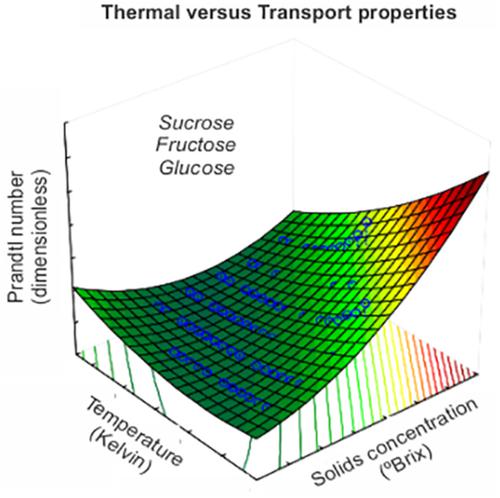当前位置:
X-MOL 学术
›
J. Food Process Eng.
›
论文详情
Our official English website, www.x-mol.net, welcomes your
feedback! (Note: you will need to create a separate account there.)
Thermophysical properties of carbohydrate solutions: Correlation between thermal and transport properties
Journal of Food Process Engineering ( IF 2.7 ) Pub Date : 2020-07-14 , DOI: 10.1111/jfpe.13483 Maria Júlia Neves Martins 1 , Bianca Guimarães 1 , Tiago Carregari Polachini 1, 2 , Javier Telis‐Romero 1
Journal of Food Process Engineering ( IF 2.7 ) Pub Date : 2020-07-14 , DOI: 10.1111/jfpe.13483 Maria Júlia Neves Martins 1 , Bianca Guimarães 1 , Tiago Carregari Polachini 1, 2 , Javier Telis‐Romero 1
Affiliation

|
Sugar solutions such as sucrose, glucose and fructose are often used in osmotic dehydration processes. Thus, the experimental determination of their thermophysical properties is a must for designing purposes. Density, specific heat and thermal conductivity were determined in a wide range of solute concentration (10–60 °Brix) and temperature (273.15–358.15 K). Empirical equations were considered to fit the experimental data and to evaluate the data behavior. An assessment based on the Prandtl number was considered to correlate thermal and rheological data. Higher density and lower specific heat and thermal conductivity values were observed when temperature decreased and solute concentration increased. Prandtl number behaved similarly as density, indicating that momentum transfer is favored in comparison with heat transfer in more concentrated solutions at lower temperatures. A versatile polynomial model concerning the significant variables could predict the experimental values for all solutions with good accuracy (R2 > .9863 and MRE < 1.20%). Reported data and equations showed to be essential for engineering aspects and transport phenomena analysis.
中文翻译:

碳水化合物溶液的热物理性质:热性质和传输性质之间的相关性
诸如蔗糖,葡萄糖和果糖的糖溶液通常用于渗透性脱水过程中。因此,对于设计目的,必须对它们的热物理性质进行实验确定。在很宽的溶质浓度(10–60°Brix)和温度(273.15–358.15 K)范围内确定密度,比热和热导率。经验公式被认为适合实验数据并评估数据行为。基于普朗特数的评估被认为与热学和流变学数据相关。当温度降低和溶质浓度增加时,观察到较高的密度和较低的比热和热导率值。Prandtl数的行为与密度相似,表明与在较低温度下更浓缩的溶液中进行热传递相比,动量传递更为有利。涉及重要变量的通用多项式模型可以很好地预测所有解决方案的实验值(R 2 > .9863,MRE <1.20%)。报告的数据和方程式对于工程方面和运输现象分析至关重要。
更新日期:2020-07-14
中文翻译:

碳水化合物溶液的热物理性质:热性质和传输性质之间的相关性
诸如蔗糖,葡萄糖和果糖的糖溶液通常用于渗透性脱水过程中。因此,对于设计目的,必须对它们的热物理性质进行实验确定。在很宽的溶质浓度(10–60°Brix)和温度(273.15–358.15 K)范围内确定密度,比热和热导率。经验公式被认为适合实验数据并评估数据行为。基于普朗特数的评估被认为与热学和流变学数据相关。当温度降低和溶质浓度增加时,观察到较高的密度和较低的比热和热导率值。Prandtl数的行为与密度相似,表明与在较低温度下更浓缩的溶液中进行热传递相比,动量传递更为有利。涉及重要变量的通用多项式模型可以很好地预测所有解决方案的实验值(R 2 > .9863,MRE <1.20%)。报告的数据和方程式对于工程方面和运输现象分析至关重要。











































 京公网安备 11010802027423号
京公网安备 11010802027423号